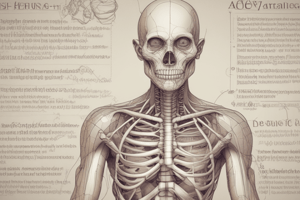Podcast
Questions and Answers
What is the term for the study of the changes that occur in the body as a result of disease?
What is the term for the study of the changes that occur in the body as a result of disease?
- Etiology
- Pharmacodynamics
- Pathology (correct)
- Syndrome
What type of surgical procedure involves cutting into the body?
What type of surgical procedure involves cutting into the body?
- Diagnostic
- Invasive (correct)
- Therapeutic
- Non-invasive
What is the term for the study of how drugs affect the body?
What is the term for the study of how drugs affect the body?
- Pharmacokinetics
- Pathology
- Etiology
- Pharmacodynamics (correct)
What is the term for a set of symptoms that occur together?
What is the term for a set of symptoms that occur together?
What type of radiology uses radiation to treat conditions?
What type of radiology uses radiation to treat conditions?
What is the term for the imaginary lines that divide the body into sections?
What is the term for the imaginary lines that divide the body into sections?
What is the term for the study of the causes of diseases?
What is the term for the study of the causes of diseases?
What is the term for the use of imaging techniques to diagnose conditions?
What is the term for the use of imaging techniques to diagnose conditions?
Flashcards are hidden until you start studying
Study Notes
Anatomy
- Root words: Words that form the base of a medical term, often related to a specific body part or system (e.g. "card-" for heart)
- Prefixes: Added to the beginning of a root word to modify its meaning (e.g. "endo-" meaning inside)
- Suffixes: Added to the end of a root word to modify its meaning (e.g. "-itis" meaning inflammation)
- Body planes: Imaginary lines that divide the body into sections (e.g. sagittal, frontal, transverse)
- Directional terms: Used to describe the location of body parts relative to each other (e.g. anterior, posterior, superior)
Diseases
- Etiology: The study of the causes of diseases
- Pathology: The study of the changes that occur in the body as a result of disease
- Symptoms: Subjective experiences of a disease (e.g. pain, fever)
- Signs: Objective indicators of a disease (e.g. rash, swelling)
- Syndrome: A set of symptoms that occur together (e.g. Down syndrome)
Surgical
- Invasive: Surgical procedures that involve cutting into the body (e.g. laparotomy)
- Non-invasive: Surgical procedures that do not involve cutting into the body (e.g. laser surgery)
- Diagnostic: Surgical procedures used to diagnose a condition (e.g. biopsy)
- Therapeutic: Surgical procedures used to treat a condition (e.g. tumor removal)
- Laparoscopic: Minimally invasive surgical procedures using a laparoscope
Radiology
- Diagnostic imaging: The use of imaging techniques to diagnose conditions (e.g. X-ray, CT, MRI)
- Therapeutic radiology: The use of radiation to treat conditions (e.g. cancer treatment)
- Modalities: Types of imaging techniques (e.g. ultrasound, mammography)
- Contrast agents: Substances used to enhance image quality (e.g. dyes, barium)
Pharmacology
- Pharmacodynamics: The study of how drugs affect the body
- Pharmacokinetics: The study of how the body affects drugs (e.g. absorption, distribution)
- Drug classification: The grouping of drugs by their mechanism of action or therapeutic use (e.g. antibiotics, analgesics)
- Route of administration: The way in which a drug is given to the patient (e.g. oral, IV, topical)
- Drug interactions: The effects of multiple drugs on each other (e.g. synergistic, antagonistic)
Anatomy
- Root words form the base of a medical term, often related to a specific body part or system, such as "card-" for heart.
- Prefixes modify the meaning of root words when added to the beginning, like "endo-" meaning inside.
- Suffixes modify the meaning of root words when added to the end, like "-itis" meaning inflammation.
- Body planes are imaginary lines that divide the body into sections, including sagittal, frontal, and transverse.
- Directional terms describe the location of body parts relative to each other, such as anterior, posterior, and superior.
Diseases
- Etiology studies the causes of diseases.
- Pathology examines the changes that occur in the body as a result of disease.
- Symptoms are subjective experiences of a disease, like pain or fever.
- Signs are objective indicators of a disease, such as a rash or swelling.
- Syndrome refers to a set of symptoms that occur together, like Down syndrome.
Surgical
- Invasive procedures involve cutting into the body, such as laparotomy.
- Non-invasive procedures do not involve cutting into the body, like laser surgery.
- Diagnostic procedures are used to diagnose a condition, like biopsy.
- Therapeutic procedures are used to treat a condition, like tumor removal.
- Laparoscopic procedures are minimally invasive and use a laparoscope.
Radiology
- Diagnostic imaging uses imaging techniques to diagnose conditions, like X-ray, CT, and MRI.
- Therapeutic radiology uses radiation to treat conditions, like cancer treatment.
- Modalities refer to types of imaging techniques, such as ultrasound and mammography.
- Contrast agents are substances used to enhance image quality, like dyes and barium.
Pharmacology
- Pharmacodynamics studies how drugs affect the body.
- Pharmacokinetics examines how the body affects drugs, including absorption and distribution.
- Drug classification groups drugs by their mechanism of action or therapeutic use, like antibiotics and analgesics.
- Route of administration refers to the way a drug is given to a patient, such as oral, IV, or topical.
- Drug interactions occur when multiple drugs affect each other, resulting in synergistic or antagonistic effects.
Studying That Suits You
Use AI to generate personalized quizzes and flashcards to suit your learning preferences.




